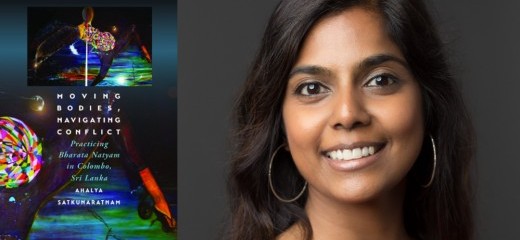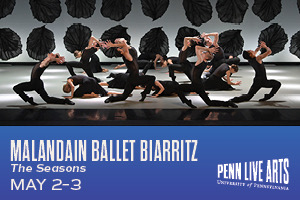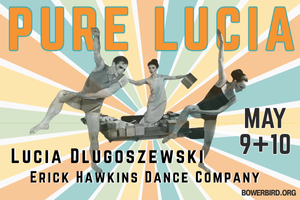
Navigating Conflict Through Bharata Natyam
by Kara Nepomuceno
Moving Bodies, Navigating Conflict is the first book of dance scholarship to study bharata natyam in Sri Lanka, and the first to examine bharata natyam’s role during the civil war, from 1983 to 2009. Author Ahalya Satkunaratnam analyzes over ten years of interviews with bharata natyam artists, students, and producers based in Colombo, Sri Lanka. Satkunaratnam is a professor of arts and humanities at Quest University Canada, located on Skwxwú7mesh (Squamish) land, and a choreographer whose work tracks the Global War on Terror as it changes over time. The ethnography is informed by her experiences as an educator, a woman of the Tamil diaspora, and a bharata natyam artist.
Moving Bodies examines classical dance and state violence, a relationship which has resonated with my experiences learning pangalay in the Philippine diaspora. Having previously read Rachmi D. Larasati’s work on classical dance and conflict during the Suharto dictatorship in Indonesia, I felt compelled to read Moving Bodies. I approached the book eager to understand how dancers navigate conditions of conflict and globalization, even as they advocate for transformative change.
Navigating conflict
Moving Bodies offers a fresh, reflexive analysis in four chapters. The first chapter examines differences between bharata natyam as a practice of cultural exchange in the 1940s, when the form first arrived in Sri Lanka. It follows the form’s shifting meanings throughout the Sri Lankan War, a conflict between the Tamil Tigers and the majority-Sinhalese state. The second chapter studies bharata natyam in Sri Lanka’s segregated educational system. Here, the “aesthetic requirement” compels students to learn a culturally-specific art form but further reinforces ethnic bounds. The third and fourth chapters offer close readings of bharata natyam performance: Satkunaratnam attends a dual recital shared by a Tamil and Sinhalese student. She then navigates commercial pressures as a performer on a Sri Lankan TV program. Artists working with culturally-specific forms will recognize many of the experiences described here, particularly the worn conflict of perceived modernity v. tradition.
The book demonstrates how static perceptions of bharata natyam are used in the service of building national power through culture. Satkunaratnam reveals the ways bharata natyam has become representative of an unchanging Tamil identity, while Kandyan dance has come to represent the Sinhalese majority. As codified dances with state-determined pedagogies, they become “a type of development project for the postcolonial nation” (53). Artists attempt to propose peace or earn state approval through many strategies, including choreography and production, as well as the performers, music, and languages they choose to present. The book values ambivalence as it reads the ways bharata natyam dancers produce different understandings of dance, nationhood, and neoliberalism, in the context of war.
Listening beyond
Throughout Moving Bodies, I was moved by the ways Satkunaratnam critically engages her interviewees’ words and actions while treating them with care. In one interview, Satkunaratnam speaks with a teacher invested in “multicultural” performance, a term criticized for obscuring “the unevenness of power” that permeates representations of cultural difference (117). Rather than dismiss the teacher’s comment, Satkunaratnam analyzes the teacher’s body in performance and excavates further meaning through her choreography. Listening beyond the teacher’s words, Satkunaratnam attends deeply to the body, modeling how embodied, performative choices can provide depth and clarity.
Moving Bodies patiently advocates for rigorous understandings and expressions of power through bodily choice. The book invited me to reflect on ways I can bring physicality into everyday communication. I recalled the many times I have criticized my Filipino family of origin for using words such as “multiculturalism” in their description of cultural performance. In the past, I experienced different forms of communication that did not account for their relationship with English. Satkunaratnam’s ethnographic methods generously model alternative ways to cultivate understanding. The book demonstrates expansive, embodied listening to those for whom English is a second language, and especially those who are not fluent in the specialized language of dance studies scholarship.
Unearthing systems of power
Moving Bodies is a critical ethnography informed by “transnational feminist scholarship, ‘third world’ feminist discourse, and postcolonial theory” (11). For readers new to ethnography, take heart: the book describes and defines terms with clarity and attention to place. For example, Satkunaratnam writes on concepts of “indigeneity” which are understood differently on Turtle Island than in Sri Lanka (18, 58). Newcomers to bharata natyam and carnatic music will find sufficient descriptions of movement and musical vocabulary in the index.
Satkunaratnam does not aim to criticize the individual, rather, her analysis reveals the underlying pressures that motivate individual actions. The book doesn’t point fingers but rather unearths the systems which perpetuate violence. Such systems turn aesthetics into “a form of discipline of the body and of the mind … that train[s] the body for postcolonial nation building...” (69). Attentive to larger networks of power, the book models futures in dance research that attune deeply to body, place, identity, and the ambivalence of performance in the context of neoliberalism and globalization. Readers will leave with a greater understanding of embodied research and attention to asymmetry in the performance of identity, inclusion, and peace.
Ahalya Satkunaratnam, Moving Bodies, Navigating Conflict: Practicing Bharata Natyam in Colombo, Sri Lanka. Middletown, CT: Wesleyan University Press, 2020. 200 pp.
By Kara Nepomuceno
April 17, 2021











